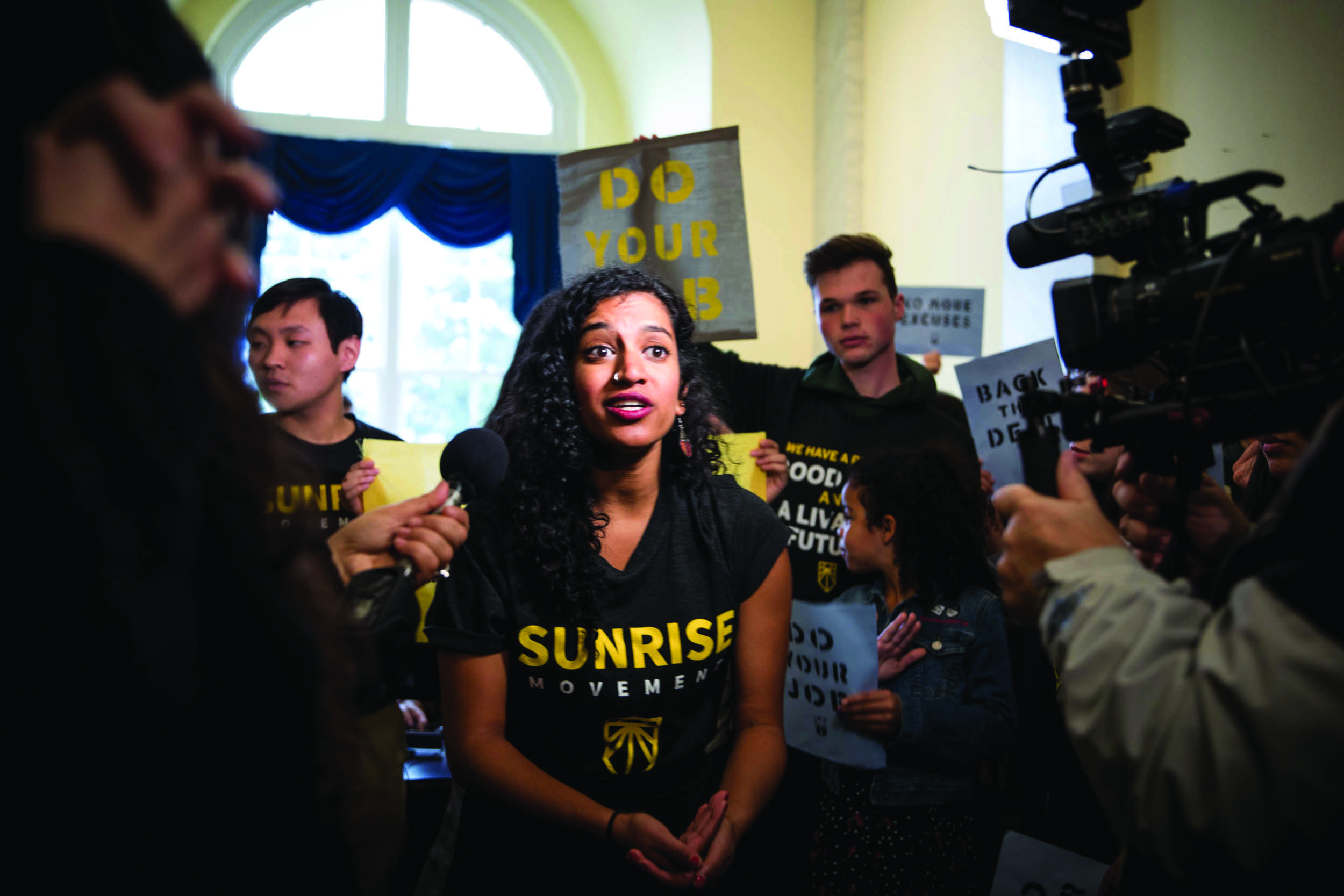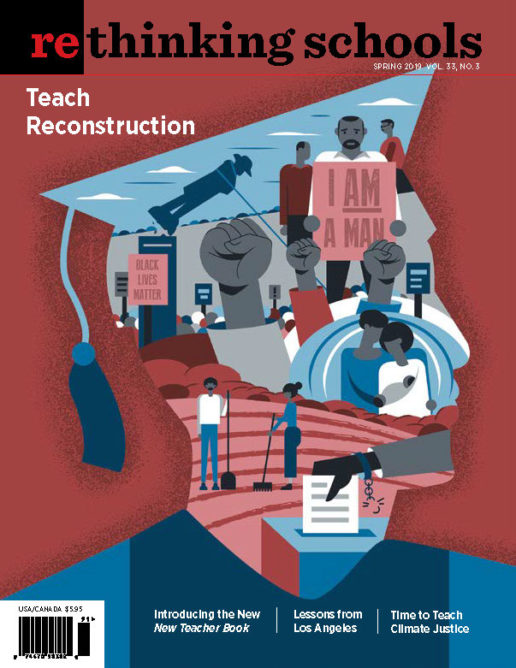Our House Is on Fire — Time to Teach Climate Justice
Column: Earth, Justice, and Our Classrooms

“I want you to act as you would in a crisis. I want you to act as if our house is on fire. Because it is.”
Those are the words of Greta Thunberg, the 15-year-old high school student whose protests outside the Swedish parliament building helped spark the ongoing student strikes for the climate throughout Europe and Australia. As Jake Woodier of the Youth Climate Coalition, which helps coordinate the strikes in Great Britain, told the Guardian: “The images of what Greta did and then the huge strikes by schoolchildren in other countries have been widely shared by young people on social media and have really inspired people.”
This explosion of global youth climate justice activism is an encouraging development. And things are building in the United States, as groups like Zero Hour and U.S. Youth Climate Strike emulate students around the world and are organizing climate strikes here. As U.S. Youth Climate Strike announces in their defiant “Why We Are Striking” statement: “We are running out of time, and we won’t be silent any longer.”
For too long, the fossil fuel industry has tried to buy teachers’ and students’ silence by saddling us with a curriculum of climate denialism, funding propaganda like the Heartland Institute’s Why Scientists Disagree About Global Warming, distributed free to tens of thousands of teachers, and spreading climate change doubt that made its way into mainstream textbooks. The gulf between the severity of the climate crisis and the curricular response in schools continues to yawn wide. This is where we come in. Social justice educators need to expose the biased and damaging curriculum and construct an alternative.
This spring, Rethinking Schools launches our “Teach Climate Justice” campaign through the Zinn Education Project, which we coordinate with Teaching for Change: bit.ly/ZEP_Climate. Our aim is to create an online library of free, downloadable K-12 climate justice curriculum and other teaching resources, host conversations for teachers to reflect on issues in teaching climate change, offer workshops on climate justice teaching, and promote the urgency of climate justice education. We need to teach like our house is on fire. Because it is.
At the site, we are assembling role plays, poetry activities, simulations, mixers, stories, and curriculum to accompany films. Some of these are lessons that first appeared in Rethinking Schools, like Eric Fishman’s “Where Are the Climate Change Superheroes?,” which describes an imaginative game he uses with his 4th graders about how climate change is unfolding in Costa Rica, with kids taking on the roles of avocado trees and the quetzal — a revered bird. In “Teaching to the Heart,” Michelle Nicola shows how she uses Kathy Jetil-Kijiner’s poignant, student-friendly poem “Dear Matafele Peinam” with her 7th graders. Another lesson, Ursula Wolfe-Rocca’s “Standing with Standing Rock,” is a role play that helps students see who benefits and who suffers from the Dakota Access Pipeline, and introduces students to those who resist.
We are also adding lessons from our book, A People’s Curriculum for the Earth: Teaching Climate Change and the Environmental Crisis. These help students consider the systemic roots of global warming, like the trial role play “Who’s to Blame for the Climate Crisis?” and “The Thingamabob Game,” a simulation that immerses students in the incentives and pressures that discourage corporations from lowering greenhouse gas emissions.
We also intend for Teach Climate Justice to be a discussion forum. We’ll include early drafts of lessons and invite people to test these out and to comment. We are posting a new climate activist mixer that Portland, Oregon, teachers Matt Reed and Tim Swinehart led for 75 teachers at a recent Teach Climate Justice event. In the mixer, participants take on the personas of climate justice and anti-fossil fuel activists from around the world — especially young activists like Xiuhtezcatl Martinez of Earth Guardians and Our Children’s Trust and Simmone Ahiaku, a founder of the Fossil Free campaign in the United Kingdom — and learn about the breadth of movement strategies by meeting diverse activists. It’s an activity that shows students how climate justice is inseparable from racial justice, gender justice, and economic justice.
Our Teach Climate Justice campaign will offer professional development workshops by some of the teachers and writers featured at our site. These face-to-face workshops engage participants in activities as we would our students, but also allow teachers to air questions and share their own teaching insights. Recently, I led a daylong A People’s Curriculum for the Earth workshop at Florida Atlantic University’s Pine Jog Environmental Education Center, for about 30 teachers. Days like this — filled with laughter, aha’s, teaching stories, and imagination — show that climate justice education needn’t be grim.
Why Climate Justice?
It’s worth pausing to talk about why climate justice, and not simply climate literacy. In Portland, where I work with the school district’s Climate Justice Committee, we frequently encounter people who want to assign climate teaching solely to science classes. If we could reduce the problem to the carbon cycle, then that might make sense. Yes, learning the science of climate change is essential, but that does not automatically help us analyze its causes, its consequences, or its potential solutions. For that, we need a climate justice approach:
- Probe its deep causes. If the United States is the richest, most educated, most scientifically advanced society, then what created our current planetary crisis? To answer that question, we need a curriculum that looks critically at the history and present characteristics of the capitalist economic system that prizes profit and accumulation, while sacrificing so many people and entire species in the process. What are the systemic imperatives that have led to our dire predicament? And we need to examine our culture’s anthropocentrism, its presumption that humans should dominate nature.
- Focus on race and inequality, on “frontline” communities. Our language about the climate crisis can inadvertently, and wrongly, equalize it. The climate belongs to us all; global warming is happening everywhere on Earth — so all must be similarly affected. But students need to see how this crisis is tearing through the world in profoundly unequal ways — with some losing lands and lives, and others cushioned from its effects behind gates of privilege. Just one example: When tropical storm Harvey, bloated with moisture by climate change, slammed into the huge ExxonMobil refinery in Baytown, Texas, those first exposed to the spilled toxic chemicals were the adjoining communities, overwhelmingly people of color.
- Student activism. The climate justice resolution passed in 2016 by the Portland Board of Education states that “students should develop confidence and passion when it comes to making a positive difference in society, and come to see themselves as activists and leaders for social and environmental justice.” Of course, this would be important even if we were not facing a climate emergency, but when students grasp the enormity of the crisis, it can lead to anxiety and despair. Activism is the antidote. Students need a people’s history curriculum that shows them the popular roots of positive social change. But more than that, they need opportunities to feel their own power to make a difference — like those organizing today’s student strikes and demanding a Green New Deal.
- Focus on deep solutions. A curriculum that engages students in asking about the fundamental social and economic origins of the climate crisis should match that inquiry with a willingness to encourage students to imagine the social changes that would reverse its causes. As Naomi Klein writes toward the end of her book This Changes Everything: Capitalism vs. the Climate, we are not simply talking about recycling or conservation; confronting the climate crisis means joining a “battle of worldviews, a process of rebuilding and reinventing the very idea of the collective, the communal, the commons, the civil, and the civic after so many decades of attack and neglect.” This is the utopian (in the best sense of the word), imaginative, hopeful study that our students need to engage in.
These are some of the principles that animate our new Teach Climate Justice campaign.
Please join us in this important work. Visit the site. Download our resources. Comment on lessons. Share this campaign (#TeachClimateJustice) on social media and with colleagues. Contact us about writing up your own climate justice lessons. Consider organizing a climate justice workshop in your school district, university, or community. Our house is on fire. No matter what we teach, this work belongs to all of us.

